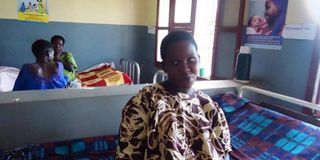An innovative method improving safe delivery

Expectant mothers at the shed in Kakindo Health Centre IV. PHOTO BY AGATHA AYEBAZIBWE
Kampala- Today is International Safe Motherhood Day. But even as Uganda joins the rest of the world to commemorate the day, there is not that much yet to celebrate.
About 16 women die daily due to pregnancy-related problems including delays at home, poor ambulance system and shortage of health workers particularly midwives. However a simple but innovative idea, the “mother waiting shed” that helps mothers with pregnancy-related complications deliver safely might significantly reduce maternal deaths.
Goretti Kobusinguzi, a 30-year-old mother of four, is testimony to that. Kobusinguzi went for her first antenatal visit, at Kakindo Health Centre IV in Kibaale District two weeks to her expected date of delivery.
The doctor found out that she had a transverse lie – a condition where the baby is lying sideways across the abdomen. Ideally, at 38 weeks of pregnancy, the baby should be lying in a head down position preparing for birth.
But Kobusinguzi’s baby was not moving into that position and the doctor told her that the condition was going to present challenges during delivery and it would be almost impossible to give birth normally.
Kobusinguzi a resident of Kabamba, 30kms away from the nearest health centre (Kakindo Health Centre IV), was then admitted in the mother waiting shed from where she would be regularly monitored.
She says staying in the shed – a project run by the Infectious Disease Institute for safe delivery – was such a relief since she didn’t have money to spend on transport to and from the centre for monitoring. Kobusinguzi, who had previously suffered three miscarriages, moved into the mother waiting shed with her mother as her attendant.
Sixteen days after, her baby was delivered by caesarean section after the efforts to have the baby position changed to the normal delivery position failed.
Dr Hargreaves Byaruhanga, a medical officer at Kakindo health centre, says Kobusinguzi was able to return home with a bouncing baby girl because her complication was identified early and interventions employed to ensure a safe delivery, something he says would have been difficult if she had opted for a traditional birth attendant (TBA) as she had done for her previous four pregnancies.
The mothers’ waiting shed is a concept that is currently being explored in Kibaale District to manage mothers at risk who are identified during antenatal care visits. The project is under the Save the Mothers - Giving a Life project.
According to Dr Brenda Picho, the Maternal-Child Health Project Manager at the Infectious Diseases Institute, Makerere University, the mothers’ waiting shed provides an option for at-risk mothers, particularly those travelling from distant villages and those with obstetric complications.
Picho says mothers can stay at the shed for as long as is necessary. “For example, depending on the risk identified, we also consider things like the distance from the mother’s home to the nearest health centre in case of an emergency.”
The project has been implemented in Uganda and Zambia. In Uganda, it is only being implemented in Kibaale District because it is one of the hard to reach districts with the challenges of the terrain, bad health system and poor transport.
Four waiting sheds in Kibaale, Kakumiro, Kakindo health centres IV and Kagadi Hospital have so far been constructed.
Each shed accommodates 16 mothers at a go with at least one attendant.
The Kakindo Health Centre IV theatre was also made functional several years after it had been abandoned due to lack of equipment, and two medical officers and an anaesthetic officer were employed at the start of the project late last year.
Health workers at the facility say the shed has helped the patients in various ways.
“100 per cent of mothers who wait from the shed have gone home with live babies. It has made it easier to monitor the mothers progressively and created mother ambassadors who go back to the communities and give testimonies to other pregnant mothers about the services,” Dr Byaruhanga says, adding that if the concept is adopted across the country, the number of women dying during delivery would significantly be reduced.




